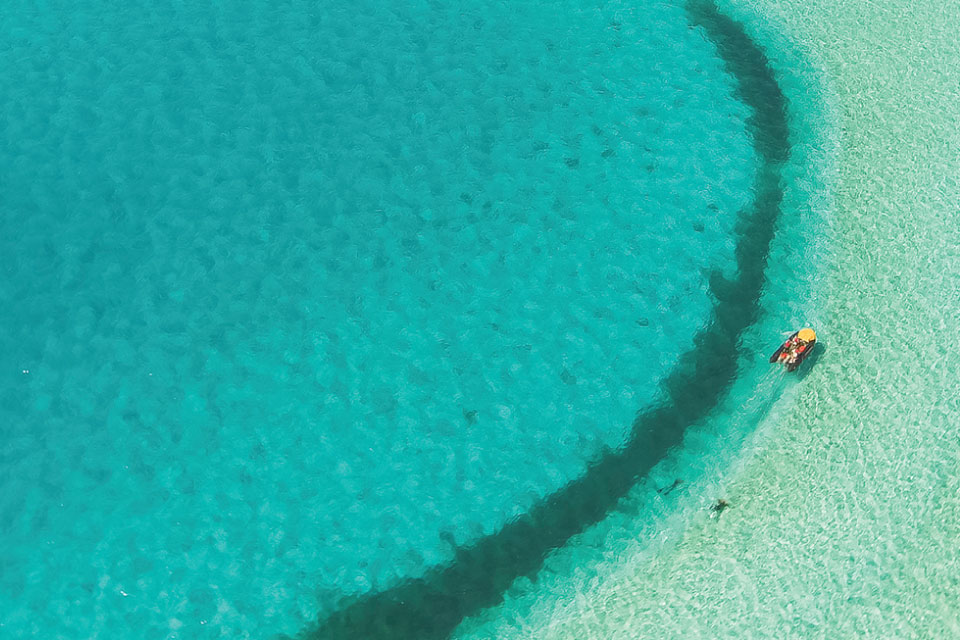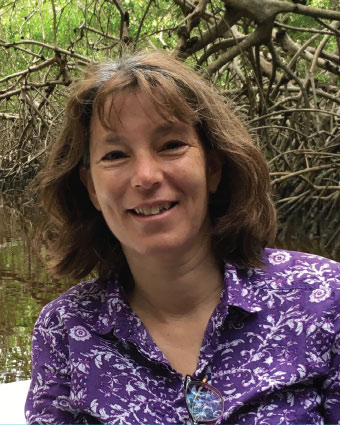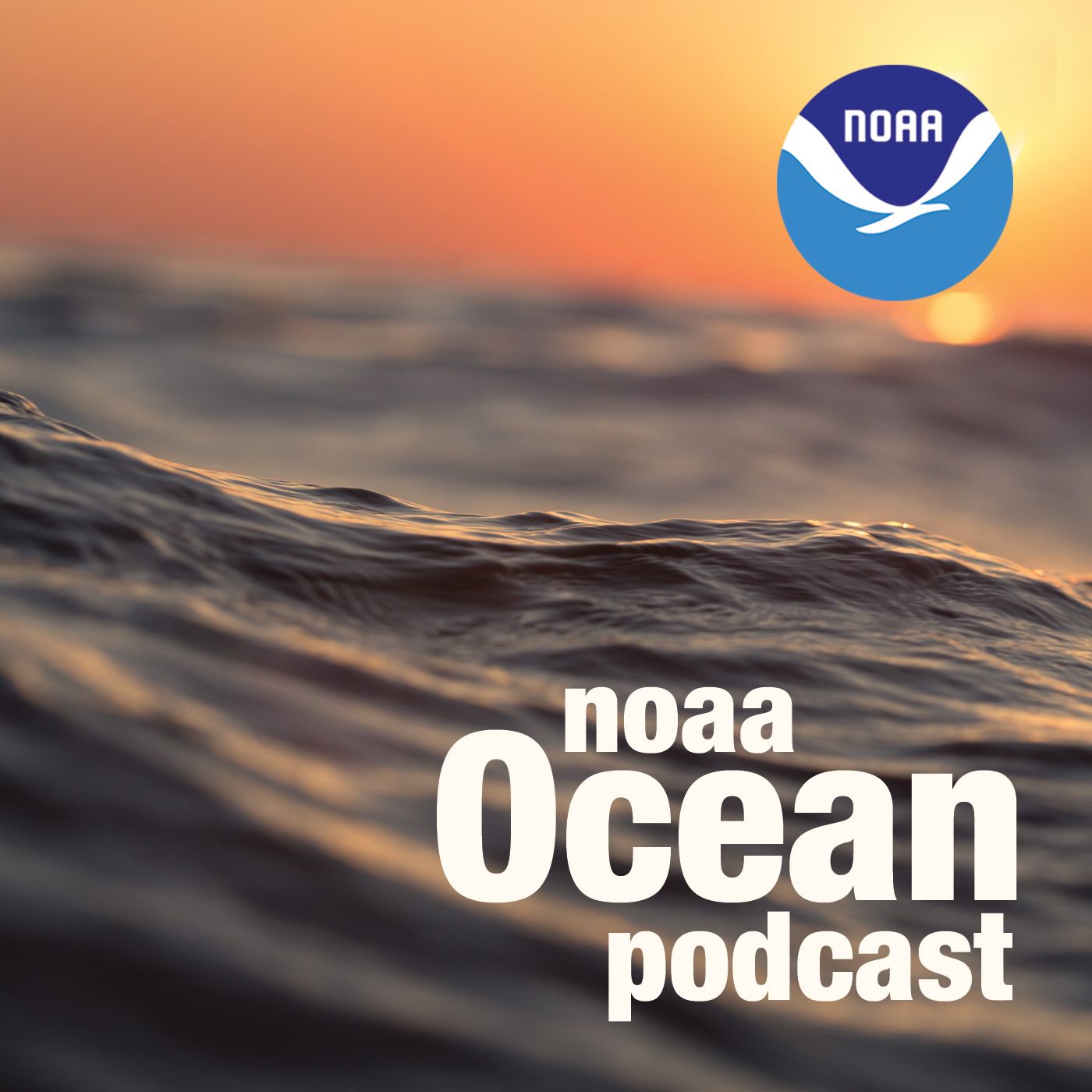Marine Protected Areas: Conserving America’s Ocean and Coasts
NOAA Ocean Podcast: Episode 49
From protecting kelp forests and corals to inspiring international collaboration with a common goal, Marine Protected Areas (MPAs) play a vital role in conserving our Earth’s special marine places. In this episode, we speak with Lauren Wenzel, director of NOAA’s National Marine Protected Areas Center, about the importance of MPAs, NOAA’s role in managing them, and what the future might look like for these special places.

Aerial view of Papahānaumokuākea Marine National Monument, the largest marine conservation area in the world.
Transcript

Lauren Wenzel, director, NOAA’s National Marine Protected Areas Center
HOST: This is the NOAA Ocean podcast. I’m Abby Reid.
Recently, I had the pleasure of speaking with Lauren Wenzel, director of NOAA’s National Marine Protected Areas Center, about the importance of Marine Protected Areas, NOAA’s role in managing them, and what the future might look like for these special places.
The term “Marine Protected Area,” or MPA, for short, is a broad one. It describes a place in our ocean, estuaries, or Great Lakes where human activities are managed to protect important natural or cultural resources.
There’s a chance that you’ve visited a Marine Protected Area but didn’t even know it. There are hundreds of MPAs throughout the United States where visitors can fish, dive, swim, snorkel, bird, hike, boat, and explore. And there are many more protected areas throughout the world.
But MPAs don’t just provide opportunities for recreation. They safeguard habitats and ecosystems that are vital to the health of our planet, and may even play a role in helping to fight the climate crisis, as Lauren will describe.
With that, let’s jump right in and find out more about these special places.
HOST: Welcome Lauren, thanks for taking the time to meet with me today, and to tell our listeners all about Marine Protected Areas. First, please tell us a little bit about yourself, and what you do at NOAA.
LAUREN WENZEL: Thanks Abby. I’m really excited to be here, so I appreciate you inviting me. I’m the director of NOAA’s National Marine Protected Areas Center, which is also a partnership with the Department of Interior. The MPA Center was created 21 years ago to support all Marine Protected Area programs.
So those include those managed by federal agencies, states, territories, tribal entities. And our role is really to provide tools, science, and information, and also to encourage international collaboration on Marine Protected Areas.
HOST: That sounds like an amazing job. Let’s talk about what Marine Protected Areas, or MPAs are, their history, and why they’re important.
LAUREN WENZEL: Right. So starting with what MPAs are, in many ways Marine Protected Areas, or MPAs, are like protected areas on land, like national parks or national wildlife refuges. And in fact the marine parts of parks and refuges are considered to be MPAs. So our National Marine Sanctuaries, National Estuarine Research Reserves, and many other coastal and marine areas managed by states and territories.
There is some confusion about the term MPA. A lot of people think it means an area where all fishing and other extracted uses are banned, but in fact it’s a broader, more flexible term that includes all areas in the oceans and great lakes that have been set aside for long-term conservation of nature, and the benefits that nature provides to people.
The idea of Marine Protected Areas goes back a long way. Many Pacific Island cultures have traditionally put areas off limits to fishing and gathering to ensure that they can help sustain other areas.
But the first official MPA in the U.S. was Pelican Island Refuge in Florida, which was created in 1903 by President Teddy Roosevelt at the urging of a then new organization, the Audubon Society, which was created to protect birds from the plumage trade for ladies’ hats. Bird populations in South Florida were being decimated by hunters, and so the Audubon Society lobbied the President to create a protected area to conserve these birds, and Pelican Island was the first of these. It was also the first national wildlife refuge, so the roots of marine conservation go back over a century.
HOST: That’s a really fascinating history because, you know, ladies’ hats.
Laughter.
LAUREN WENZEL: You don’t think of marine conservation as, as having a focus that came out of ladies hats. And I just wanted to mention that MPAs are important because they’re a proven tool for conserving marine species, habitats, and ecosystems.
So MPAs provide a host of ecological benefits, but of course they also provide economic, spiritual, cultural benefits to all of us who go there to relax, recreate, and enjoy these places.
HOST: So, what role does NOAA play in creating and managing MPAs?
LAUREN WENZEL: NOAA manages some marine protected areas directly. It manages the national marine sanctuaries program, and it works with states to manage the National Estuarine Research Reserves. And NOAA is also a manager of the national marine monuments, particularly those in the, in the remote Pacific.
And then of course NOAA is also responsible for federal fisheries management, which works with MPA programs to make sure that fisheries impacts aren’t harming MPA resources.
And of course NOAA is home to the MPA center, which is where I work. And so, we are a partnership organization that looks across all of the diverse MPA programs and really encourages collaboration and partnerships.
HOST: How do MPA managers use science to design the best, most effective MPAs?
LAUREN WENZEL: MPAs are designed to meet specific conservation goals. So the first step is deciding what you want the MPA to do. And then those goals determine where the MPA is located, its size, its shape, other considerations like that.
Many MPAs are established to protect a particular feature, like a canyon or a sea mount, an upwelling area, or a hard-bottom reef. And others may be created because they’re feeding or breeding grounds for important species. Managing agencies rely on ocean science to understand the ecological importance of certain areas. And I think that there’s a huge amount that we can learn, and a, and a great opportunity for more indiginous-led conservation across the U.S. And particularly in Alaska, where the ocean is so integrated into the way of life for indigenous peoples. And it needs to be integrated into any future conservation effort.
HOST: Thank you, thank you for that. And another question I had, kind of going off of my original question. What kind of scientists are working in these areas?
LAUREN WENZEL: It’s a great question Abby, and I think the answer is so many different kinds of science contribute to marine protected area management. Obviously marine ecology, but also oceanography, marine chemistry. Also the social science, understanding the economics of marine management. But also sociology and anthropology to understand how people interact with these places. So, there is a huge breadth of scientific knowledge that needs to come into play to inform marine management.
HOST: Sounds like such a collaborative and holistic effort. What role do Marine Protected Areas play in responding to a changing climate? And, can MPAs be part of the climate solution?
LAUREN WENZEL: Yeah, great question. So like everywhere in the ocean, MPAs are being affected by climate change. The ocean has absorbed more than 90% of the excess heat generated by our emissions of greenhouse gases, and about 30% of the carbon dioxide. And as a result ocean waters, including MPA waters, are getting warmer, more acidic, and contain less oxygen. And ocean and coastal areas are also experiencing more frequent and intense coastal storms, and changing ocean currents. There’s no doubt that MPAs are being affected by these climate impacts.
But the good news is that MPAs can be part of the solution to climate change. A huge portion of the Earth’s carbon is stored in marine ecosystems and in marine sediments. And so protecting and restoring those resources can prevent additional carbon from being released into the atmosphere.
The name that scientists have given to carbon stored in the ocean is Blue Carbon. And this is best understood as coastal habitats like tidal wetlands, seagrasses, and mangroves, that take up and store more carbon on a per unit basis than terrestrial forests. But scientists are also taking a closer look at other carbon stored in marine habitats, like kelp and seaweed, and also in ocean sediments.
So I think there’s huge potential for the ocean and for MPAs in particular to play a role in, in terms of climate solutions. And then of course we have the ability to manage MPAs to adapt to climate impacts. And as we understand these impacts better, we can look at actions to reduce their harm to marine resources. And this can be as simple as reducing non-climate stressors in MPAs so that they can be more resilient to climate impacts. So this might be looking at ways to reduce impacts, like dredging, fishing, or noise in order to allow those resources to be healthier and more resilient.
And then another step that managers can take is looking at solutions like planting more disease and heat-tolerant corals to restore reefs, or looking at heat-tolerant kelp species. So we’re really looking very broadly at the whole spectrum of solutions to climate change adaptation, as well as mitigating climate impacts.
HOST: It sounds really challenging, but also very exciting to take this on.
LAUREN WENZEL: I think that’s right. I mean, I think climate is the 800 pound gorilla in the room, or maybe the elephant seal, in this case.
Laughter.
It’s something we can’t ignore, and it can seem daunting, but we absolutely need to start addressing it if we’re going to do our job as MPA managers.
HOST: How much of the ocean within U.S. borders is protected?
LAUREN WENZEL: About 26% of the U.S. ocean is protected. One of our jobs at the MPA center is to maintain an MPA inventory so we can track all the MPAs managed by different federal and state agencies. And that’s the number that we have determined meets the international definition of a marine protected area. So that allows us to be consistent when we report and compare ourselves to other countries.
But it’s important to note that this area’s not evenly distributed around the U.S. Almost all of it, 96% of MPA area, is in the remote Pacific, where there are these large-scale MPAs in marine national monuments, like Papahānaumokuākea, and also the Pacific Remote Islands Marine National Monument.
So what that means is that a lot of other parts of the U.S. are not seeing the benefits of Marine Protected Areas in their waters.
HOST: That’s a perfect segway to my next question. There’s a goal to conserve at least 30% of our lands and waters by 2030. What role will NOAA play in working to achieve this goal?
LAUREN WENZEL: Yeah it is a really exciting opportunity. And I should say that while I’m a big believer in goals and I think it’s great to have that 30% target to inspire momentum, we also need to recognize that that 30%’s not an end point. What we really want is healthier waters that deliver these benefits to coastal communities and other folks who live around the country.
And so, the initiative is an opportunity to scale up our conservation efforts in the U.S. And it really looks at supporting community-led conservation. The three goals of the initiative are to protect biological diversity, improve climate resilience, and make natural areas more accessible to everyone, including groups that have traditionally been excluded.
And NOAA is supporting this goal by continuing progress to establish new National Marine Sanctuaries and new National Estuarine Research Reserves. And also by working with regional fishery management councils to identify actions that they can take to support place-based conservation.
With sanctuaries, communities can actually submit nominations to have places that they are about considered for designation as national marine sanctuaries if they meet the criteria for national designation. So it really gives communities the power to take that action.
HOST: I don’t know how much of the public actually knows that, so I’m glad that you mentioned that here.
I understand that NOAA works with other countries to safeguard marine protected areas. Tell me about what this collaborative effort looks like.
LAUREN WENZEL: So some of the things that we do include international capacity building, where we work with another country to identify some of their needs and then design a training and mentoring program to meet those needs. So we’ve been working in many countries around the world with donor agencies who help support these projects financially, and then NOAA brings the scientific and management expertise.
And we really convene this process, and then allow people to learn from each other, because there is so much that managers can share when they have a chance to be part of a formal process of, of knowledge sharing. So that’s been really exciting, and has been going on for over 15 years.
We also have sister sites, which is really a, a cool idea where different MPAs may share a resource or habitat or cultural tradition and want to work together.
For example, Stellwagen Bank National Marine Sanctuary off the coast of Cape Cod is an important feeding ground for large whales. And the humpback whales that feed at Stellwagen migrate down to the Caribbean, including the Dominican Republic, and so the Dominican Republic and several other Caribbean countries have formed sister site partnership with Stellwagen to share information about the management of that same population of humpback whales as they migrate from their feeding grounds in the north to their breeding grounds in the south.
And then we also have a sister site partnership between Rapa Nui, also known as Easter Island, in Chile, and Papahānaumokuākea. Both island cultures are Polynesian and have a fascinating history of a common ancestry that diverged hundreds of years ago, and have parallel cultures but, but they are very distinct. And so they were tremendously excited to learn from each other, particularly in terms of the active native Hawaiian management of Papahānaumokuākea, and what that might look like translated into a context for Rapa Nui. And so the Rapa Nui people formally adopted a Marine Protected Area having met with Papahāna and understanding what they would like to see as co-managers of that important ocean area.
So it’s really exciting to see those partnerships take root and people really learning from and respecting and being excited by each other’s experience.
HOST: Right, these aren’t just scientific partnerships, they’re cultural partnerships, and exchanges, and that is exciting.
So, you’ve given a great overview of the history of MPAs and where we are now. What does the future of MPAs look like for NOAA?
LAUREN WENZEL: Well I think it’s a really exciting and challenging time. We have a, a great opportunity through this Biden-Harris administration initiative, called America the Beautiful, about establishing more conservation for 30% by 2030. We’re focusing even more than ever before on addressing climate impacts and also working with indigienous partners. And we’re focusing on working toward long-term conservation outcomes. We know the ocean is changing and pressures on the ocean continue to mount, so how can we continue to manage these areas to achieve those long-term conservation outcomes and to work with other people?
So I think, you know, the future of MPAs is, is all about cooperation and just keeping our eyes on that long-term conservation that we want to achieve.
HOST: From protecting kelp forests and corals, to inspiring international collaboration with a common goal, and so much more, marine protected areas play a vital role in safeguarding our Earth’s special marine places.
Be sure to check out our show notes for additional resources about Marine Protected Areas, and visit oceanservice.noaa.gov to explore an array of ocean science resources.
Thanks for listening.

From corals to coastal science, connect with ocean experts to explore questions about the ocean environment.
Social